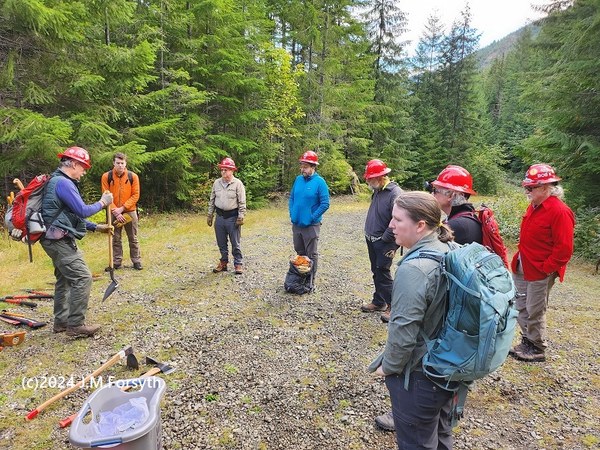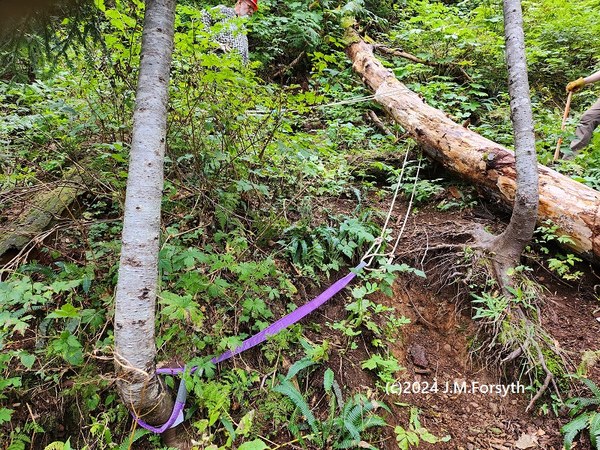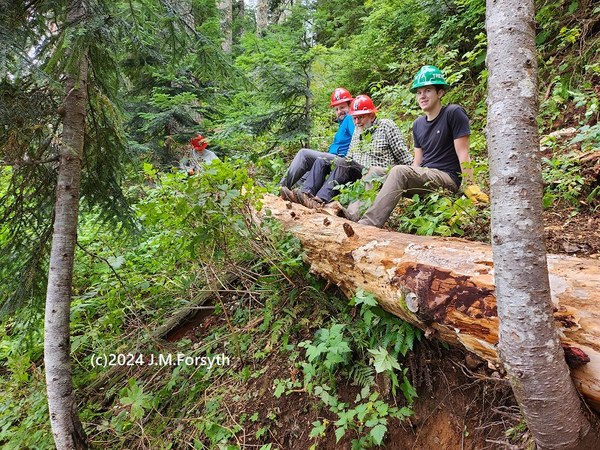
Trip Report
Stewardship - Church Creek–Satsop Lakes
Is it worth carrying a tool that weighs as much as three Pulaskis? Read this story of the Olympia Branch's trip to Church Creek Trail on National Public Lands Day to find out.
- Sat, Sep 28, 2024
- Stewardship - Church Creek–Satsop Lakes
- Church Creek–Satsop Lakes
- Stewardship
- Successful
-

- Road recommended for high clearance only
-
Church Creek's East Trailhead is reached via Forest Service Roads 23, 2361, and the spur dead-ending at the trailhead, 2361-600. Road 23 has been greatly improved since June 2024, with a lot of grading and some filling of potholes with gravel. Road 2361 is gravel and in good condition. Road 2361-600 has 28 water bars in 2.2 miles, some of which would likely cause a sedan or coupe to bottom out. SUVs and pickup trucks can manage the road without scraping. There is a seasonal gate where 2361 splits from 23, and that gate is locked from October through May. No parking pass or permit is required at this trailhead.
Church Creek and Church Mountain were named after Frederic Church – not the Hudson River School painter, but a member of the 1890 Second O’Neil expedition exploring the interior of the Olympic Peninsula. The Church Creek Trail starts near where Church Creek empties into the Lower South Fork of the Skokomish River. It is a series of switchbacks, under towering firs, cedars and hemlocks, rising to an open pass where a now-decommissioned forest road crossed a height of land, now with alpine meadow wildflowers below a steep rock cut. It then continues on switchbacks through more forest, mostly more evergreens of respectable size, crossing the divide between the Skokomish and Wynoochee watersheds, and descending through a mixed forest to a tall grassy meadow around Satsop Lake, and eventually a Forest Road trailhead. On some of the switchback corners on the Church Creek side, one can lean out a little between big trees to look almost straight down into a canyon hundreds of feet deep.
The Olympic National Forest office of the Forest Service asked the Olympia Branch to adopt and maintain this trail, and we agreed. It is a challenging trail to maintain because the driving time to the trailhead is significant, made longer by the condition of the Forest Service roads (better now than it was a few months ago), and a long, steep hike carrying tools to wherever one is going to work. Our scouting of the trail in September 2023 and May 2024 revealed brush encroaching on the trail, heavily in some places, some sloughing starting to fill in the bench of the tread of the trail, and two problem fallen trees across the trail, among other items. Both trees were in the upper section, above the old forest road. One of the trees was a huge Doug fir, which had been down for years. We discussed a lot of plans for taking it out but deferred it for another time. The other was a tree which had fallen uphill at a switchback turn, lying across the elbow of the turn, so to speak, across both the uphill approach to the turn and the downhill approach. A hikers’ shortcut had developed between the upper and lower legs, using a living tree as a handrail going up, and a fireman’s pole going down the 3-4’ difference in height. The trail was becoming badly eroded, and the roots of the tree beginning to be exposed.
We determined to work on this on our next stewardship trip. We evolved a plan to restore the switchback turn. We would cut the log across the trail, and move pieces of it, and possibly another nearby log, to serve as curb logs and other structural elements stabilizing and supporting the upper and lower legs of the trail, and to extend the point of the turn to where it had probably been originally, on the far side of the fallen log.

On June 1, 2024, National Trails Day, we headed up the trail with enough tools to do most of the work on fixing that switchback, as well as some brushing, lopping and tread re-benching tools and a couple of saws, with plans to split into groups for each task. Carrying a lot of gear up a fairly steep (1,250’ in about 1.7 mile) trail slowed us down. When we stopped for lunch before getting to the work site, it was plain that we were running into a time problem. At the job site, we tried sawing the fallen log. We made cuts in two places about twelve feet apart. At both cuts, after gaining a good bit of depth, the saw blade bogged down in punky, high moisture wood. When we drove in wedges to try to keep the kerf open, they pretty much sunk into the wood, rather than pushing the sides of the cut apart. We were out of time, and abandoned our efforts working on the turn. Meanwhile, we had split up after lunch and part of the crew had some success removing fallen limbs and a couple of logs from the trail, and cutting back some brush.
Learning from the June 1 trip, we made modest but realistic plans for a day’s work. We would narrow the task to finishing the cuts on that log, and moving the cut pieces into place. We would not bring tools for other parts of the plan, which would follow later. A week before this trip, I had been on another trail crew project where a rope come-along, or ratchet winch with a handle, was used for moving small boulders. This seemed just the ticket for moving the log sections. A drawback is weight: the ratchet winch and one hundred feet of 15 mm (0.6”) rope weighs 16 pounds. That is equal to the weight of three of the Forest Service’s standby axe-adze combination tool, the Pulaski. On the other hand, on June 1st, we carried in a tool for moving logs called a peavey. The peavey seemed to weigh about as much as three guys named Pulaski, and we were not going to carry it up that hill again.
On September 28, which I later learned was National Public Lands Day, we had an on-time meet-up at Haggens at 7:00 am and were driving by about 7:15. We had a brief re-grouping and bathroom break at the fish hatchery just off US 101, then continued to the trailhead, arriving about 9:00. We did the tailgate briefing,
with Assistant Leader Tom Keenan giving the tool talk.

We organized the participants into a group of four: Tom, Sandy Clark, Chandler Church and Bob Keranen, dedicated to brushing and re-benching on the lower and middle sections of the trail. I took a group of five: Prescott Church, Clark Reid-McKee, Trevor Hipwell and Brett Werenski, and headed for the upper section and the switchback project.
We were on the trail hiking by 9:45. At 11:10, we reached the old forest road in the pass at 2,850 feet, having gained about 1,000’ above the trailhead. Brett, Clark, Preston and Trevor posed for a photo at the top of the pass.

I was very pleasantly surprised to see that the Doug fir of about 42” diameter, which had necessitated a climb-over or crawl under, had been taken out. Someone with a chainsaw had made very efficient cuts, leaving neat, flat cut ends, into which the chain sawyer plunge cut the initial “T”. Thank you, Mister or Ms. T. That would have been a headache job for crosscut sawyers.
We arrived at our job site at 11:50, an improvement of more than an hour over our arrival time on June 1, and had lunch before starting. I had set a hard finish time of 2:00 pm. First, we set up the rope come-along. Two of the crew took a 20’ x 2 inch strap, and girth-hitched it around a four-foot diameter cedar tree above the work site for our anchor.

We led the end toward the log to be moved, and extended it with a doubled rope sling and an eight-foot by two-inch strap, and hooked the come-along into that. As the operation progressed, I saw that these extensions were not needed; the hundred foot rope, even when doubled in this rig, was long enough without them. We ran the come-along rope through a rescue pulley of sufficient diameter, and back to the eight foot strap attached to the anchor at the cedar tree. Running the rope through a moving pulley doubled the pulling power compared to a single-part straight pull. The manufacturer claimed a 1,600 pound pulling capacity, so this theoretically gave us a 2:1 mechanical advantage, for 3,200 pounds of pull.

We set up what is called a parbuckle, attaching the pulley to a rope (actually one piece of rope doubled for strength) passed over the log, down and around the far side of the log to be moved, under it and then securing it with a 6.5’ by 2-inch sling girth-hitched around a tree in the desired direction of travel for the section of the log, when cut.

Passing the rope around the log to be moved, when the log is rolling and moving, effectively makes the log another moving pulley in the system and adds another 2:1 mechanical advantage. After the attack on Pearl Harbor, naval salvors passed multiple wire rope parbuckles around capsized warships, and used heavy wire block and tackle arrangements to roll the ships over and turn them upright. It works with logs, too.
We lined up the system, starting out with Preston Church (relation to Frederic unknown) on the lever, Brett Werenski tending the rope coming out of the winch, Clark Reid-McKee keeping the ropes straight, and Trevor Hipwell standing by the log with a Pulaski, ready to start chopping.

Preston started cranking the lever, and the rope and pulley system took a strain. The log had saw cuts in two places, but apparently not all the way through. Starting with Trevor, we began taking turns with a forester’s axe and the Pulaski, chopping away at the log.

After more axe work at both ends of the section we wanted to move, the log separated, but did not roll as readily as we expected. When it finally did, we saw that an unseen stub on the underside had been driven into the ground, and had been holding it.
With some more cranking, and some changes in the rope set-up to keep the log going in the desired direction, it was in position just above where we wanted it to wind up. We got the rigging out of the way, and administered the coup de grace with butts and boots, and gravity in our favor.

The log dropped easily the rest of the way, coming to rest against the bases of the two trees.
This completely removed the obstruction from the upper approach to the turn. The remainder of the fallen tree still blocked some of the lower approach, but a small path was now open.
I looked at my watch and saw that it was 1:58 pm. Close enough to our 2:00 pm turn-around time to pack up, have a drink and a snack, and start the easier hike downhill. The brushing and benching team were out ahead of us. We debriefed and socialized over snacks and drinks before starting the drive home.
We plan on coming back next year, probably in June, to continue this project. We will cut another section off the fallen tree to open the lower approach further, and probably move it with the come-along to a useful location. We will build some rock or wood cribbing to prove more support and protection from erosion in the steep area between the two live trees. We will do a good bit of shovel work, digging drainage and moving dirt and rock for fill, and grading the trail in the area of the turn. If you are interested, please set your profile preferences to get notified of Olympia stewardship trips. We would be happy to have you join us.
 Mike Forsyth
Mike Forsyth